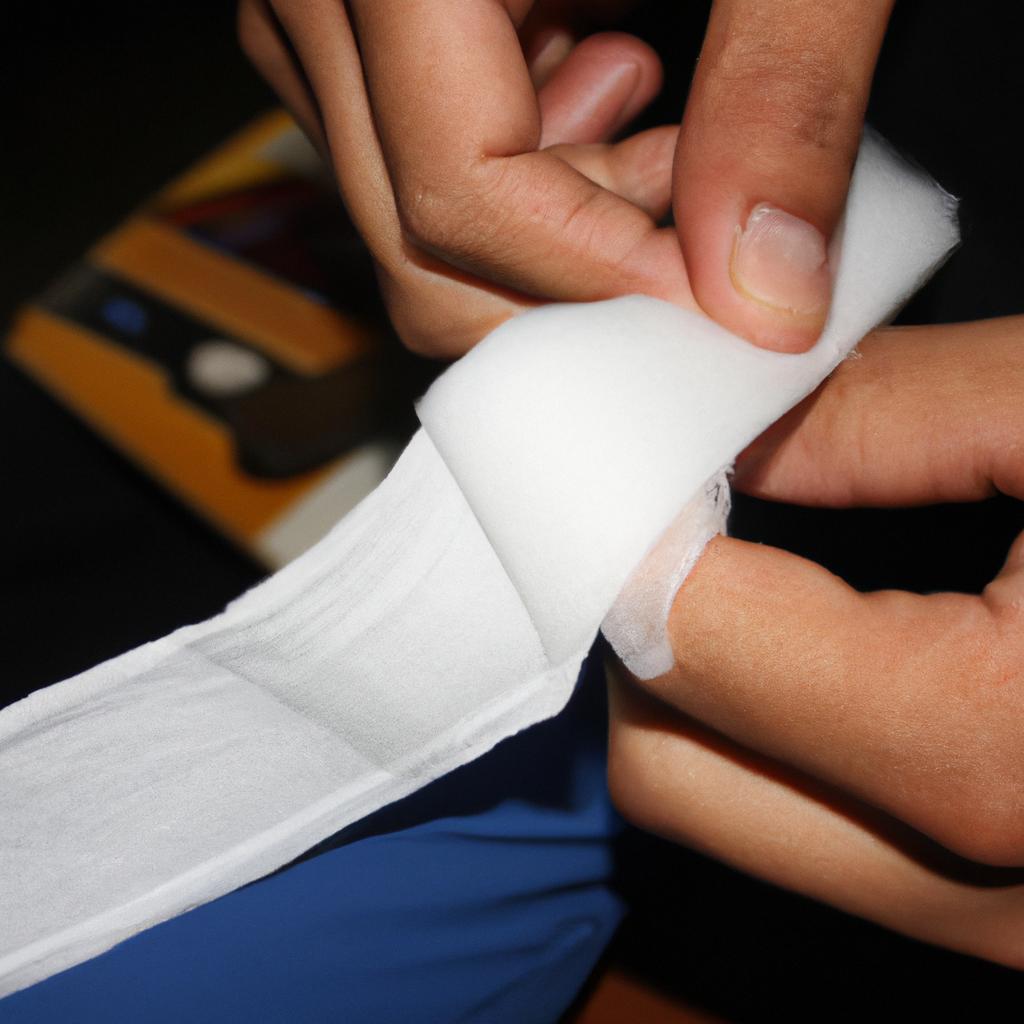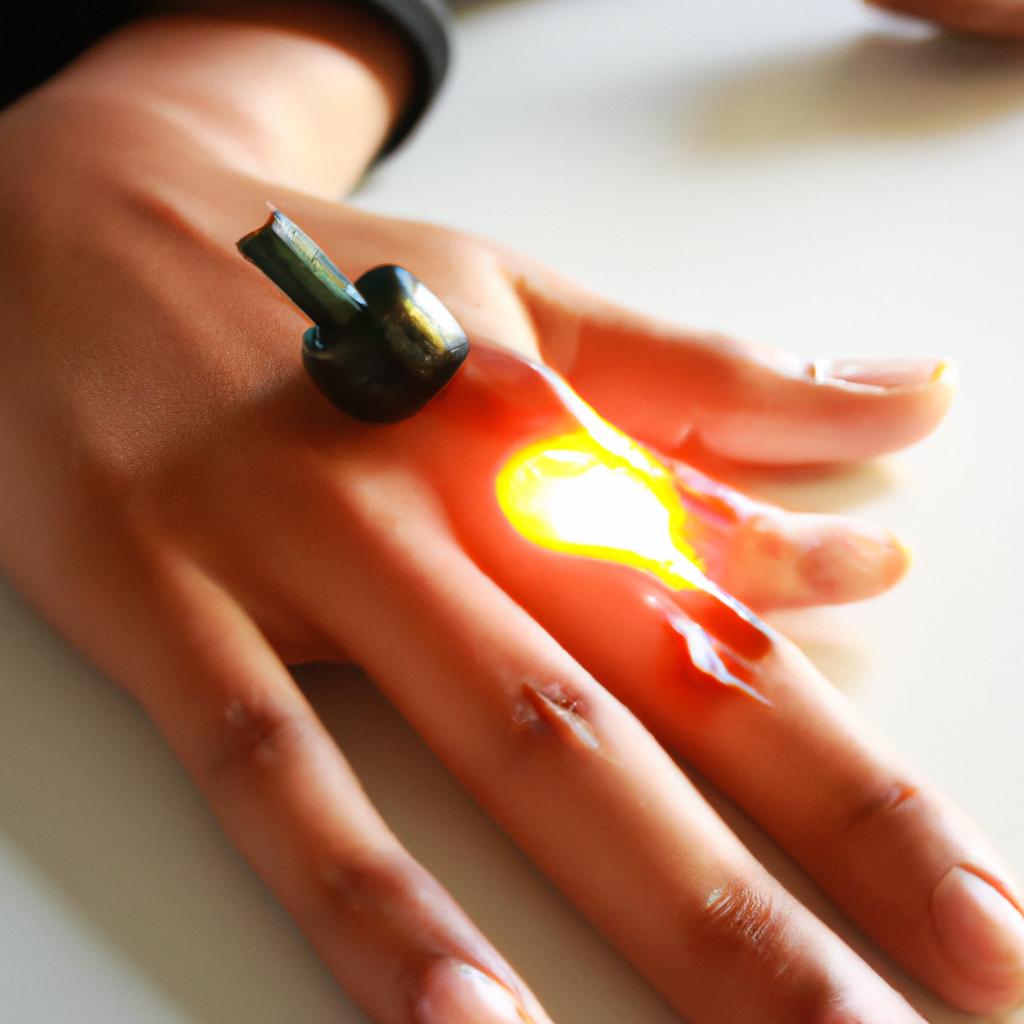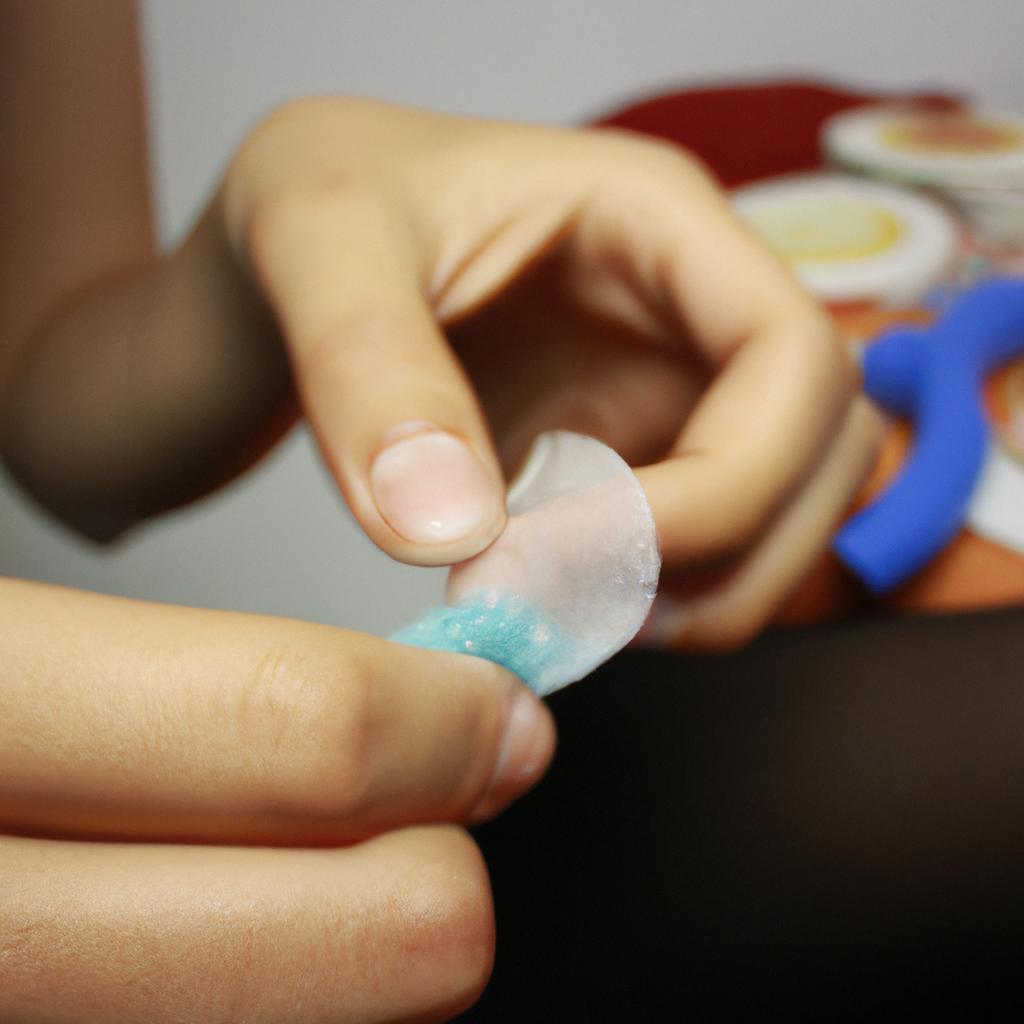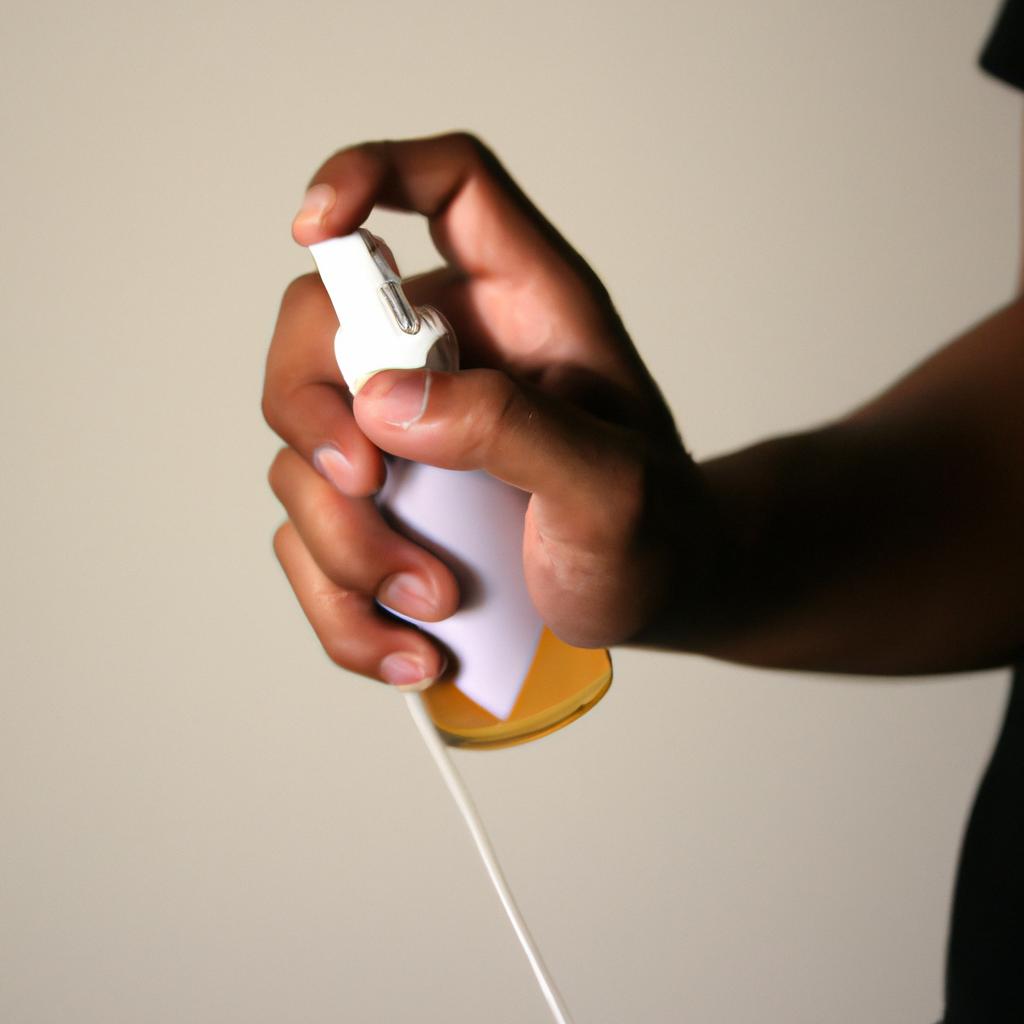Adhesive bandages play a crucial role in providing effective first aid for wound care. These small, self-adhering strips of material are designed to cover and protect minor cuts, abrasions, or other superficial injuries. They are widely recognized as an essential component of any well-stocked first aid kit due to their convenience, versatility, and effectiveness in promoting the healing process.
For instance, consider a hypothetical scenario where an individual sustains a shallow cut while preparing food in the kitchen. In such cases, adhesive bandages offer immediate protection by creating a barrier between the wound and external contaminants. This prevents further injury and reduces the risk of infection. Moreover, they facilitate the natural healing process by keeping the wound clean and moist, enabling cells to regenerate more efficiently. The simplicity of application ensures that even individuals without medical training can easily utilize adhesive bandages for prompt wound care at home or on-the-go.
When it comes to first aid supplies, adhesive bandages should never be underestimated or overlooked. Their importance lies not only in their ability to provide physical protection but also in their psychological impact on patients. By offering reassurance through visible coverage and gentle pressure on the wound site, these bandages instill confidence and promote emotional comfort during times of distress. Consequently , adhesive bandages contribute to a holistic approach to wound care by addressing both the physical and emotional aspects of healing.
What are adhesive bandages?
Imagine a scenario where someone accidentally cuts their finger while preparing food in the kitchen. The cut is not severe enough to require stitches, but it does need protection and care to prevent infection. This is where adhesive bandages come into play. Adhesive bandages, also known as plasters or Band-Aids (a popular brand name), are essential first aid supplies designed specifically for wound care.
Adhesive bandages consist of three main components: an absorbent pad, an adhesive backing, and a protective covering. The absorbent pad is placed directly over the wound to soak up any blood or other fluids that may be present. It helps keep the wound clean and promotes healing by providing a barrier against bacteria and dirt.
The adhesive backing allows the bandage to stick securely to the skin surrounding the wound, ensuring that it stays in place even during daily activities such as showering or exercising. Additionally, the protective covering acts as a shield against external factors like water, dust, and germs from entering the wound.
To emphasize the importance of adhesive bandages in wound care, consider these emotional bullet points:
- Provides immediate relief by protecting wounds from further harm
- Eases anxiety by offering reassurance that wounds are being properly cared for
- Encourages independence in self-care practices
- Promotes faster healing process through effective wound management
Furthermore, let’s delve into a 3-column table showcasing different types of adhesive bandages available on the market today:
| Type of Adhesive Bandage | Features | Benefits |
|---|---|---|
| Standard | Basic design with absorbent pad and waterproof top | Suitable for small cuts or abrasions |
| Fabric | Soft fabric material | Ideal for sensitive skin and flexible movement |
| Waterproof | Water-resistant materials | Allows bathing without removing |
| Antibacterial | Contains antibacterial agent | Helps prevent infection and promote healing |
In summary, adhesive bandages are essential components of first aid kits. They provide a convenient and effective way to protect minor wounds from further injury and support the healing process.
Types of adhesive bandages
Adhesive Bandages: Essential First Aid Supplies for Wound Care
Adhesive bandages, also known as sticking plasters or simply bandaids, are an essential component of any well-stocked first aid kit. These small, flexible strips consist of a non-stick pad attached to a sticky adhesive backing that helps keep the wound protected and secure. Adhesive bandages come in various sizes and shapes to accommodate different types of wounds, from minor cuts and scrapes to blisters and abrasions.
For instance, imagine a scenario where someone accidentally cuts their finger while preparing dinner. In this situation, an appropriate size adhesive bandage can be applied over the cut to protect it from further contamination and provide cushioning for enhanced healing. This example highlights the practicality of adhesive bandages in everyday situations.
There is a wide range of adhesive bandages available on the market today, each designed with unique features to address specific wound care needs. Some common types include:
- Standard fabric or plastic strip: These traditional rectangular-shaped bandages are commonly used for simple cuts and scratches.
- Waterproof or water-resistant: Ideal for protecting wounds during activities involving water exposure, such as swimming or showering.
- Antibacterial: Infused with antimicrobial agents like silver ions or iodine to help prevent infection in wounds.
- Advanced dressings: Designed for more complex injuries, these bandages may incorporate additional features such as gel pads for optimal wound healing.
These variations demonstrate how adhesive bandages have evolved beyond basic wound coverage into specialized products tailored towards specific circumstances.
The use of adhesive bandages has become ubiquitous due to their convenience and effectiveness in providing quick relief and protection against potential infections. Furthermore, they offer numerous benefits when it comes to wound care management. In the subsequent section about “Benefits of using adhesive bandages for wound care,” we will explore these advantages in greater detail, shedding light on why adhesive bandages are an indispensable asset for first aid purposes.
Benefits of using adhesive bandages for wound care
Section Title: The Importance of Adhesive Bandages in Wound Care
Imagine a scenario where you accidentally cut your finger while preparing dinner. Without proper wound care, such an injury can lead to potential infections and complications. This is where adhesive bandages come into play as essential first aid supplies. In this section, we will explore the benefits of using adhesive bandages for wound care, highlighting their significance in promoting healing and preventing further damage.
Benefits of Using Adhesive Bandages:
-
Protection:
Adhesive bandages provide a physical barrier that shields the wound from external contaminants such as dirt, bacteria, and other harmful microorganisms. By creating a protective layer over the injured area, these bandages help reduce the risk of infection significantly. -
Moist Environment:
One key aspect of optimal wound healing is maintaining a moist environment around the wounded area. Adhesive bandages with breathable materials allow oxygen to reach the site while retaining moisture needed for cell regeneration and tissue repair. -
Absorption & Exudate Management:
Certain types of adhesive bandages are designed with absorbent pads or linings that efficiently manage exudate (fluid discharge) from wounds. These pads not only prevent excessive fluid accumulation but also promote faster healing by keeping the affected area clean and dry. -
Flexibility & Comfort:
Adhesive bandages offer flexibility in terms of size, shape, and material options available on the market today. Their versatility allows them to conform to various body parts’ contours and movements comfortably without restricting mobility or causing discomfort during everyday activities.
- Peace of mind knowing your wound is protected.
- Confidence in faster recovery due to optimized healing conditions.
- Convenience in carrying compact and easy-to-use bandages.
- Relief from pain and discomfort associated with open wounds.
Emotional Table:
| Benefit | Emotional Response |
|---|---|
| Protection | Safety |
| Moist Environment | Healing |
| Absorption Management | Cleanliness |
| Flexibility & Comfort | Convenience |
Understanding the benefits of adhesive bandages is crucial, but equally important is knowing how to properly apply them for optimal wound care. In the following section, we will delve into the step-by-step process of applying an adhesive bandage correctly, ensuring effective treatment and promoting speedy recovery without any complications.
How to properly apply an adhesive bandage
Imagine a scenario where you accidentally cut your finger while chopping vegetables. You quickly reach for an adhesive bandage and apply it to the wound, providing immediate relief and protection. Properly applying adhesive bandages is essential for effective wound care. In this section, we will discuss the step-by-step process of correctly applying adhesive bandages.
Firstly, before applying an adhesive bandage, ensure that the wound has been cleaned and dried properly. This helps prevent infection and promotes faster healing. Once the wound is ready, follow these steps:
-
Choose the appropriate size: Select an adhesive bandage that adequately covers the entire wound without leaving any exposed areas. It should also allow some space around the edges to adhere securely onto healthy skin.
-
Prepare the area: Gently clean around the wound using mild soap and water or an antiseptic solution if available. Pat dry with a clean towel, ensuring there is no moisture left on or near the wound.
-
Apply the bandage: Remove the protective backing from one side of the adhesive bandage, being careful not to touch the sterile pad with your fingers. Place this side directly over the wound, making sure it adheres firmly but does not cause discomfort or restrict movement.
-
Secure it in place: With one hand holding down the initial end of the adhesive bandage, gently pull across until it overlaps onto healthy skin beyond both sides of the wound site. Smooth out any wrinkles or air bubbles along its surface for optimal adherence.
To illustrate further how proper application can make a difference in promoting healing and preventing complications, consider these emotional bullet points:
- Reduced risk of dirt or bacteria entering open wounds
- Minimized exposure to irritants such as water or friction
- Enhanced protection against accidental trauma during daily activities
- Improved aesthetic appeal by covering unsightly wounds
In addition, here is a table showcasing the benefits of properly applying adhesive bandages:
| Benefits | Explanation |
|---|---|
| Protection from infection | Adhesive bandages create a barrier, preventing harmful bacteria from entering the wound. |
| Promotes faster healing | By keeping wounds clean and undisturbed, adhesive bandages aid in quick recovery. |
| Provides pain relief | The gentle pressure applied by adhesive bandages can alleviate discomfort caused by minor injuries. |
| Prevents scarring | Properly sealing wounds with adhesive bandages reduces the likelihood of visible scars forming. |
In summary, proper application of adhesive bandages involves selecting the right size, preparing the area, carefully placing it over the wound, and securing it firmly but comfortably onto healthy skin. Understanding these steps ensures effective wound care and helps promote rapid healing. Now let’s delve into tips for choosing the right adhesive bandage to further enhance your first aid knowledge.
Tips for choosing the right adhesive bandage
Imagine a young child playing in the park and accidentally scraping their knee on the rough asphalt. Without proper wound care, this minor injury can easily become infected and cause further complications. This is where adhesive bandages step in to provide essential first aid for wound care.
Adhesive bandages are simple yet effective tools that help protect wounds from dirt, bacteria, and other harmful substances while facilitating the healing process. Their versatility makes them suitable for various types of injuries such as cuts, scrapes, blisters, and burns. By applying an adhesive bandage correctly, you can ensure that the wound remains clean and protected from external elements that may hinder its healing.
To better understand the significance of adhesive bandages in wound care, consider these important points:
- Protection: Adhesive bandages act as a barrier between your skin and potential contaminants like dirt or germs.
- Absorption: Some adhesive bandages are designed with absorbent pads that help soak up any fluids or discharge from the wound.
- Comfort: The cushioning provided by certain adhesive bandages helps relieve pressure on sensitive areas and offers comfort during movement.
- Promotes Healing: By keeping the wound moist but not overly wet, adhesive bandages create an optimal environment for faster healing.
Emphasizing the importance of adhesive bandages further, let’s take a look at this table showcasing their advantages:
| Advantages of Adhesive Bandages |
|---|
| Protects against infections |
Remember that while adhesive bandages play a crucial role in wound care, they should not be used as a substitute for professional medical attention when necessary. Seeking appropriate medical assistance is always advised if you have concerns about an injury’s severity or signs of infection.
Moving forward into our next section on Proper Care and Disposal of Adhesive Bandages, we will explore the steps to ensure hygiene and safety when using adhesive bandages. By taking these precautions, you can maximize their effectiveness in promoting healing while minimizing potential risks.
Proper care and disposal of adhesive bandages
After carefully choosing the right adhesive bandage for your wound, it is equally important to ensure proper care and disposal of these essential first aid supplies. By following appropriate guidelines, you can prevent infections and promote faster healing. Let’s explore some tips on how to properly care for and dispose of adhesive bandages.
To begin with, let’s consider a hypothetical scenario where an individual sustains a small cut on their finger while preparing food in the kitchen. They immediately clean the wound with soap and water before applying an adhesive bandage to protect it from further damage. In this case, it is crucial that they follow these steps:
-
Keep the area dry: Moisture can compromise the adhesion of the bandage and create an environment favorable for bacterial growth. It is recommended to keep the wound as dry as possible during regular activities or when showering.
-
Change regularly: Adhesive bandages should be changed at least once every 24 hours or more frequently if they become wet, dirty, or lose their adhesiveness. This reduces the risk of infection by ensuring cleanliness and adequate protection.
-
Avoid reusing: Reusing adhesive bandages is not advisable as they may have come into contact with bacteria or other contaminants during previous use. Always discard used bandages after removal.
- Seal used adhesive bandages inside a plastic bag before placing them in a trash bin.
- Avoid flushing used adhesive bandages down toilets or disposing of them outdoors.
- If there are concerns about potential exposure to bloodborne pathogens (e.g., due to handling someone else’s wound), consult local regulations regarding proper medical waste disposal.
- Remember to wash hands thoroughly after handling used adhesive bandages.
Finally, here’s a table highlighting key considerations for caring and disposing of adhesive bandages:
| Care for Adhesive Bandages | Disposal of Adhesive Bandages |
|---|---|
| Keep the wound dry | Seal used bandages in a plastic bag before disposal |
| Change regularly | Avoid flushing down toilets or disposing outdoors |
| Do not reuse | Consult local regulations for medical waste disposal |
By adhering to these guidelines, individuals can ensure that their wounds are properly cared for and that adhesive bandages are disposed of responsibly. This promotes better hygiene practices and reduces the risk of infections associated with improper care or disposal methods.
In conclusion, it is essential to prioritize proper care and disposal of adhesive bandages after using them as first aid supplies. By following the outlined steps and adopting responsible practices, individuals can effectively protect themselves from potential complications and promote optimal wound healing.




